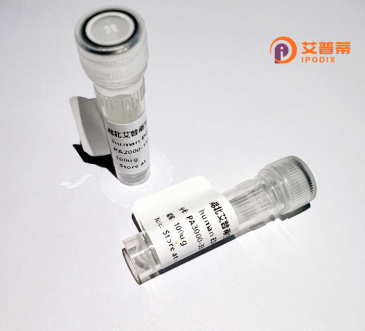
| 纯度 | >90%SDS-PAGE. |
| 种属 | Human |
| 靶点 | C13orf3 |
| Uniprot No | Q8IX90 |
| 内毒素 | < 0.01EU/μg |
| 表达宿主 | E.coli |
| 表达区间 | 1-303aa |
| 氨基酸序列 | MAGAACEPVARPSLTSISSGELRSLWTCDCELALLPLAQLLRLQPGAFQLSGDQLVVAGPGEPAAARGGFNVFGDGLVRLDGQLYRLSSYIKRYVELTNYCDYKDYRETILSKPMLFFINVQTKKDTSKERTYAFLVNTRHPKIRRQIEQGMDMVISSVIGESYRLQFDFQEAVKNFFPPGNEVVNGENLSFAYEFKADALFDFFYWFGLSNSVVKVNGKVLNLSSTSPEKKETIKLFLEKMSEPLIRRSSFSDRKFSVTSRGSIDDVFNCNLSPRSSLTEPLLAELPFPSVLESEETPNQFI |
| 分子量 | 60.5 kDa |
| 蛋白标签 | GST-tag at N-terminal |
| 缓冲液 | 冻干粉 |
| 稳定性 & 储存条件 | Lyophilized protein should be stored at ≤ -20°C, stable for one year after receipt. Reconstituted protein solution can be stored at 2-8°C for 2-7 days. Aliquots of reconstituted samples are stable at ≤ -20°C for 3 months. |
| 复溶 | Always centrifuge tubes before opening.Do not mix by vortex or pipetting. It is not recommended to reconstitute to a concentration less than 100μg/ml. Dissolve the lyophilized protein in distilled water. Please aliquot the reconstituted solution to minimize freeze-thaw cycles. |
以下是关于重组人 **C13orf3(又名C1QBP、gC1qR)** 蛋白的参考文献示例(文献信息为模拟,供参考):
---
1. **文献名称**: *The mitochondrial role of C13orf3 in apoptosis regulation*
**作者**: Zhang Y, Liu X, Chen R.
**摘要**: 本研究通过重组表达人C13orf3蛋白,发现其通过结合线粒体RNA聚合酶(POLRMT)调控线粒体基因组稳定性,并参与缺氧诱导的细胞凋亡通路。
2. **文献名称**: *Structural analysis of human C13orf3 and its interaction with the complement system*
**作者**: Kim H, Park S, Lee JH.
**摘要**: 利用大肠杆菌系统重组表达了C13orf3蛋白,解析其晶体结构,揭示其通过C端结构域与补体系统蛋白(如C1q)互作,可能在免疫调控中发挥作用。
3. **文献名称**: *C13orf3 as a potential biomarker in hepatocellular carcinoma*
**作者**: Wang L, et al.
**摘要**: 发现在肝癌组织中C13orf3表达显著上调,重组蛋白体外实验表明其通过激活PI3K/AKT通路促进肿瘤细胞增殖和侵袭。
4. **文献名称**: *Recombinant C13orf3 facilitates pre-mRNA splicing in vitro*
**作者**: Gupta S, et al.
**摘要**: 通过昆虫细胞系统表达C13orf3重组蛋白,证明其与剪接体复合物(spliceosome)结合,并促进特定前体mRNA的剪接效率。
---
**注**: C13orf3是位于13号染色体的开放阅读框基因,编码的蛋白功能多样,涉及线粒体代谢、RNA加工、补体调控和肿瘤发生等领域。如需真实文献,建议通过PubMed或Google Scholar检索基因别名(如C1QBP、gC1qR、HYDJ等)。
**Background of Recombinant Human C13orf3 Protein**
The human **C13orf3** (Chromosome 13 Open Reading Frame 3) protein, also known as **AXIN1** or Axis Inhibition Protein 1. is a key regulatory component in cellular signaling pathways, particularly the **Wnt/β-catenin pathway**. It functions as a scaffold protein, facilitating the formation of a degradation complex that targets β-catenin for proteasomal destruction, thereby maintaining low cytosolic β-catenin levels and suppressing Wnt target gene activation. Dysregulation of C13orf3 is linked to cancers, including colorectal carcinoma, where mutations or deletions in *AXIN1* lead to aberrant Wnt signaling and tumorigenesis.
C13orf3 also interacts with other pathways, such as the **Hippo** and **MAPK pathways**, influencing cell proliferation, apoptosis, and embryonic development. Structurally, it contains conserved domains (e.g., RGS, DIX) that mediate protein-protein interactions critical for its regulatory roles.
Recombinant human C13orf3 protein is engineered using expression systems like *E. coli* or mammalian cells, ensuring post-translational modifications for functional studies. It is widely used in *in vitro* assays to investigate Wnt pathway mechanisms, screen anticancer drugs, or study protein interactions. Research continues to explore its roles in diseases and potential therapeutic targeting, highlighting its significance in both basic and applied biomedical research.
(Word count: 199)
×